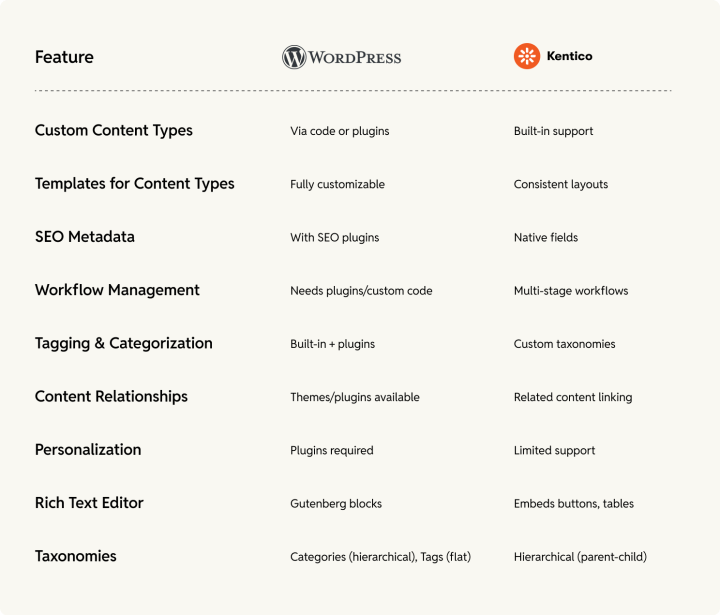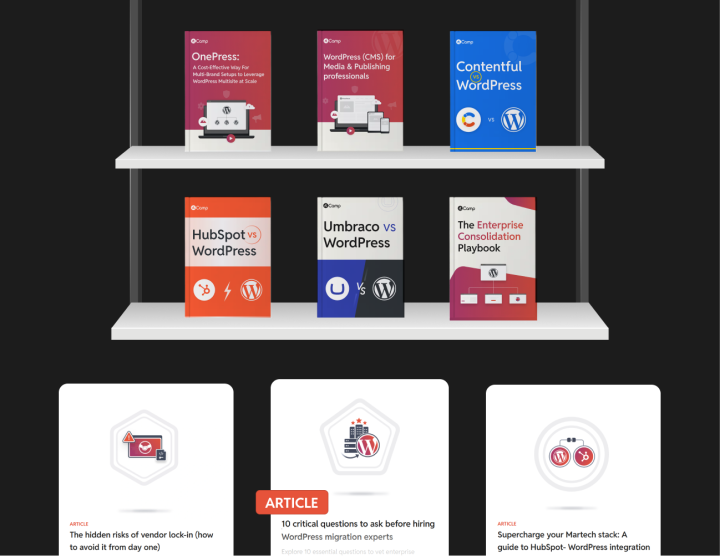Content Creation: Kentico vs WordPress
The content creation process is another key consideration when choosing a CMS. This is so because you’ll spend most of your time writing, uploading, and formatting your content in the best possible way. So the CMS must offer an intuitive interface that helps you deliver consistent brand experiences.
Both Kentico and WordPress CMS can create, organize, and publish content across multiple sites from one dashboard, making it easy to configure your sites, set up content structures, and determine how everything should be displayed.
Both offer user-friendly tools for content creation and editing, including WYSIWYG editors that let non-technical users easily design content. However, WordPress takes it a step further with Gutenberg, a block-based editor that provides more flexibility in layout design.
To help understand the differences better, we have compared both CMSs on a wide range of important parameters-

For those who want to dive deeper, here’s the full side-by-side comparison.
| Features | Kentico | WordPress |
| Content modeling using content types | Yes, supports custom content types (e.g., Blog Post, Product) with specific fields and templates. | Yes, allows custom post types (e.g., Blog Post, Product) defined through code or plugins. |
| Custom content types | Developers can define custom content types with specific fields like “Title,” “Body,” “Author,” etc. | Developers can create custom post types with fields using plugins like Custom post type UI. |
| Content type templates | Templates can be created with in-built content types as they provide consistency in layouts, making it beneficial for maintaining brand messaging across the website. | Endless customizations for control layout; custom templates can be created for different post types. This gives you greater control over the visual appearance of your content. |
| Metadata for SEO | Custom content types can include SEO-related fields for meta titles, descriptions, and schema markup. | SEO plugins (e.g., Yoast SEO) allow adding meta titles, descriptions, and schema markup easily. |
| Advanced workflow management | Configurable workflows with multiple stages (Draft, Review, Published) and user assignments for approval. | Based on requirements, workflows can be created with plugins or custom development. |
| Tagging and categorization | Custom taxonomies can be created for content items to improve discoverability. | Built-in categories and tags for organizing posts; additional taxonomies can be added via plugins. |
| Content relationships | Related content linking is supported to enable cross-promotion of items like products and case studies. | Related posts feature available through themes or plugins to link similar content together. |
| Personalization and dynamic content | Supports content personalization only to a limited extent. | Personalization typically requires plugins; basic user role-based content visibility is available. |
| Rich text editor features | Rich Text Editor supports embedding components like buttons and tables directly within content. | Gutenberg editor allows embedding blocks like buttons, images, and tables directly in posts/pages. |
| Taxonomies | Xperience 13 uses a hierarchical structure, to create categories and sub-categories of tags. Tags in taxonomy are organized into parent-child relationships. | WordPress has two default taxonomy categories and tags. Categories are hierarchical and meant to group your posts broadly. Tags are meant to describe the details of your posts. |
Version control and updates
Kentico offers robust version control and approval workflows, which are ideal for teams needing to track changes and gain stakeholder approvals before publishing.
WordPress also comes with version control and auto-saving. So you can track your content changes. Also, with plugins, you can easily add bespoke approval/editorial processes to it.
Multilingual support
Both platforms support multilingual content management, but WordPress’s plugin ecosystem allows automatic language adjustments based on a visitor’s location, which is highly useful for global audiences. Kentico also handles multilingual content, but WordPress’s wide selection of translation plugins makes it a versatile choice for websites with dynamic language needs.
In summary, while Kentico offers powerful content management and version control, WordPress shines with its flexibility, affordability, and regular updates, making it an ideal choice for businesses looking for ease of use.
Media library
| Features | Kentico | WordPress |
| Media uploading and organizing | Supports multiple file uploads and drag-and-drop functionality; uses folders for organization. | Allows uploads directly when creating posts; offers grid or list views for easy navigation. |
| Editing and managing media files | You can update existing files by uploading new versions; manual steps for bulk actions. | Easy editing of media details with automatic saving; supports bulk actions of media items. |
| Search and filtering capabilities | Basic search functionality; limited filtering options. | WordPress has an efficient system to filter media type and date; giving real-time search updates as you enter details for it. You can also customize tags as per your requirements. |
| User interface and experience | Straightforward, but may require training for new users to learn to navigate around. | Intuitive interface that is useful to both technical and non-technical users; dual view options. |
| Community support and documentation | Official documentation is available, but has a small community, resulting in limited third-party resources, creating dependencies. | Extensive documentation, forums, and tutorials are available due to a large global community. |







